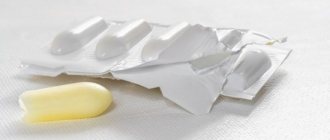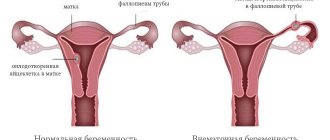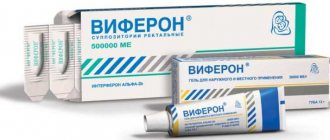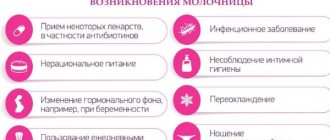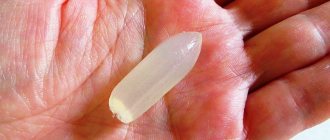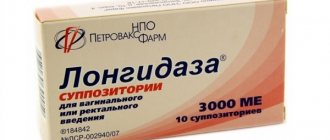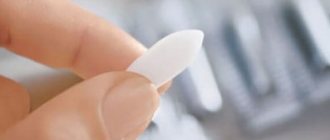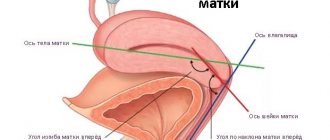Form of production
Papaverine is available in the form of tablets of 10 and 40 mg, rectal suppositories of 20 mg and a solution for injection of 20 mg in one ampoule.
The tablets have a white or yellowish tint. They are odorless, have a bitter taste, and have two perpendicular marks. For adults, the drug is available in a dosage of 40 mg, for children – 10 mg. Packed in blisters of 10 pieces. The cardboard package contains 2 blisters.
The suppositories are produced in a torpedo-shaped form for insertion into the rectum, have a white tint, and are odorless. Dosage – 20 mg. One blister contains 10 suppositories. The cardboard package includes one blister and an insert – Papaverine’s instructions.
Papaverine solution is transparent, odorless, available in ampoules of 20 mg. Cardboard packaging includes 10 ampoules.
Contraindications and possible side effects
Before using the substance with papaverine, you should carefully read the attached instructions. Thanks to medical practice, many experts argue that the use of suppositories with papaverine may be prohibited for patients whose medical records contain entries about:
- Diseases of the rectum;
- Failure of thyroid function;
- Interruptions in heart rhythm caused by AV conduction disorder;
- Disorder of bronchial functioning;
- Glaucoma – increased eye pressure;
- Disorders of the kidneys, adrenal glands and liver.
Moreover, a woman’s body during pregnancy is so unpredictable that it can at any moment respond to even the most familiar and proven product in a completely unpredictable way. Consequently, previously identified intolerance to the components of papaverine suppositories can be considered as a contraindication for use.
Possible side effects of suppositories with papaverine may be allergic irritation and minor itching. A more serious outcome may result from exceeding a certain dosage, and this is: cardiac failure, dizziness and drowsiness, increased sedation, difficulty defecating and urinating, hypotension, nausea, vomiting, etc. Treatment for overdose is hardware blood purification (hemodialysis) and symptomatic therapy.
5 suppositories in a blister. 2 blisters in a cardboard box.
Papaverine is available in three forms:
- Tablets for oral use;
- Solution;
- Rectal suppositories.
Suppositories with papaverine are classified as drugs from the myotropic antispasmodics group. The fact is that the main active substance of suppositories is an opium alkaloid. It actively affects smooth muscles, provoking its rapid relaxation. As a result, there is a noticeable relief in the patient's condition.
Having figured out how Papaverine suppositories work, it is worth finding out their composition. The shape of the suppositories is cylindrical, with a conical top. On the opposite section of the suppositories, it is possible to form a small depression in the form of a funnel. The main active ingredient of the drug is papaverine hydrochloride (20 mg per suppository). Solid fat (semi-synthetic glyceride) is used as additional components.
Compound
The composition of Papaverine depends on the form of release of the drug. In all cases, the medicine contains one active component - papaverine hydrochloride. Tablets, injection solution and suppositories include various auxiliary components. The exact information can be found in the table.
Chemical composition of various forms of Papaverine
The pharmacological group of the drug is myotropic antispasmodics, vasodilators.
International nonproprietary name (INN) – Papaverine, Papaverine (English), Papaverinum (Latin).
Release forms
The drug is available in several medicinal forms, which allows you to choose a convenient and more effective one in each specific case: these can be rectal suppositories (suppositories), injection solution, tablet form. Papaverine for children is produced separately; the amount of active ingredient in it is optimal for treatment in childhood.
Papaverine ointment
Papaverine ointment is a separate medication group. The product contains an active component - papaverine hydrochloride and auxiliary components - purified water, lanolin, sunflower oil.
Indications for use:
- conditions associated with intestinal spasms;
- spastic constipation;
- haemorrhoids;
- anal spasm;
- spasms caused by diseases of the genitourinary system.
Papaverine cream is applied to the perineum and anus to reduce pain. It is recommended to do this after carrying out hygiene procedures 2–3 times a day. If the patient uses other ointments and gels, be sure to inform the doctor about this.
papaverine and colic
I heard in the maternity hospital that you can give papaverine for colic if nothing else helps the child... well, some girls said... some did.
I tried everything: massage, diaper, tummy wrap, espumisan, bobotik, sub, dill water, baby calm... in short, everything I could (Plantex more or less helped, but it gave her constipation and green poop), my child screams. definitely not hungry, he kicks his legs, strains, grunts and then just screams like a fool... I put my hand on my stomach, and not only that, it’s swollen, there’s such a war of gases going on... I inserted a tube, it helped for 30 minutes and again I screamed at the whole house.
User comments
This is because of your gas outlet tube... the body is used to being helped to get rid of gases... and in general there is no such drug that relieves colic, so stop buying the pharmacy and just accept it - carry her in your arms, put her on your stomach so that she is warm... by 3 the month will pass on its own, be patient
does she poop often? mine myself could not poop for 2-3 days ((also screamed terribly. I gave him microlax. All the poop came out and farts. The sounds were terrible, there was so much gas in there after such enemas I began to poop myself... and farts periodically
I’ll tell you honestly, the more you do enemas, tubes, the worse it will be, every feeding give sub simplex or espumisan or something else, just choose 1 drug, not everything in a row and put it on your tummy before feeding, I was also very worried when there was colic there were, but I pulled myself together, did the same thing all the time and everything went away ugh ugh for 1.5 months already we don’t know the grief, I don’t remember at the breast you?? watch your diet, all the reasons are 100% this.
nutrition must be observed, do not eat anything that can cause bloating and gas formation, but in general colic is a thing you know, everything happens only due to the immaturity of the child’s intestines)
Yes, it's natural! Just not 100% sure
Source
Pharmacological properties
The drug papaverine has a good antispasmodic and moderate analgesic effect. Due to its ability to relieve spasm from the smooth muscles of internal organs and blood vessels, the medicine has a mild hypotensive effect. This makes it possible to use it in the initial stages of hypertension and in some other conditions characterized by increased blood pressure.
Once in the body, the active component papaverine hydrochloride inhibits the activity of phosphodiesterase enzymes, which leads to a decrease in calcium concentration in cells. This process contributes to disruption of the contractile function of smooth muscles, consequently, muscle relaxation, elimination of spasm and pain.
The medicine Papaverine is used for diseases of the respiratory, digestive, cardiovascular systems, and for diseases of the kidneys, liver, gall bladder and other organs.
Important! Despite Papaverine’s ability to relax the smooth muscles of the muscles, a person’s motor activity is completely preserved.
Papaverine dosage for children at fever
Papaverine is usually prescribed to children under one year of age to relieve spasmodic abdominal pain and intestinal colic. Reviews from parents also talk about the beneficial effects on muscle function and metabolism in the little ones when using the medication for electrophoresis.
For older children, papaverine is also recommended for other diseases. So, this medication or its analogue is recommended shortly before taking an antipyretic. Otherwise, if the limbs are cold and the temperature is extremely high, it will not have the desired effect, since the narrowed vessels will not give off excess heat and cool the body.
As prescribed by the doctor, the average course of the drug is one to two weeks. Reviews from those who have used it say that problems are resolved faster.
| Child's age | Recommended single dose |
| 6 months – 2 years | 5 mg |
| 3–6 years | 10 mg |
| 7–9 years | 15 mg |
| 10–14 years | 20 mg |
The tablets are swallowed whole with the required amount of water (about a glass). The drug is used regardless of food intake, as needed, that is, for pain, severe spasm. However, with frequent spasmodic pain in the abdominal cavity, it is worth taking it fifteen to thirty minutes before meals, so that the drug stops spasmodic manifestations and the child can eat calmly.
| Child's age | Recommended single dose |
| 6 months–2 years | 0.25 ml |
| 3–4 years | 0.25–0.5 ml |
| 5–6 years | 0.5 ml |
| 7–9 years | 0.5–0.75 ml |
| 10–14 years | 0.75–1 ml |
One ampoule contains 2 ml of a two percent solution of papaverine, the total amount of the active ingredient in it is similar to that contained in a tablet for adults. Injections are given subcutaneously or intramuscularly; intravenous injections are possible in a diluted form.
The dosage of papaverine in suppositories for various diseases accompanied by contractions and spasmodic pain depends on age. For children under ten years of age, rectal suppositories with papaverine should be divided into two or four parts.
How many of these pieces are allowed? Children under four years of age can only be administered a quarter of a suppository, and children 5–10 years old can be given a half of a suppository twice a day.
Many people are interested in the question: can a child be given adult tablets, divided into pieces. Doctors do not recommend doing this. Children need low-dose tablets for children or suppositories. In severe cases, injections may be used (under medical supervision).
Overdose is determined by weakness, doubling of surrounding objects, drowsiness and decreased blood pressure. To eliminate this, the stomach is washed and the baby is given enterosorbents, such as activated carbon. If your blood pressure drops suddenly and severely, call an ambulance immediately.
The drug is contraindicated:
- Children with excessive sensitivity to the components of the drug;
- Patients with glaucoma;
- Children with serious forms of liver failure;
- Children after head injuries.
Side effects include allergic reactions to substances contained in papaverine, low blood pressure, nausea, upset stool, nausea, and excessive sweating.
SCHEME OF APPLICATION OF ANTIBREAKER AND VASUDODILATORS DRUGS AT HIGH TEMPERATURE IN CHILDREN.
- Temperature below 38º does not need to be reduced. (with the exception of febrile seizures in the past and less than 3 months of age)
- Temperature 38 - 39º
2.1 PINK FEVER
Signs: pink skin, warm feet, no chills.
Medicines: PARACETAMOL
2.2 PALE FEVER
Signs: pale or marbled skin, cold feet, chills or goose bumps.
Medicines: PARACETAMOL NO-SPA
or PARACETAMOL PAPAVERINE
3. Temperature above 39º
Medicines: PARACETAMOL NO-SPA (or PAPAVERINE) ANALGIN
The drug is ibuklin (tablets and suppositories, good for fever)
What is "pale fever"
Very dangerous for a child’s body is the so-called “pale fever” - an increase in temperature, which is accompanied by severe chills, pale skin and cold extremities; the vascular pattern on the skin may intensify, and it becomes “marbled”; There may be blue discoloration of the lips and nasolabial triangle - the area located between the lips and nose.
With “pale” fever, measures to reduce the temperature even in a strong and strong child should be taken starting from 38 degrees; If the baby has a diagnosis of any chronic disease on his card or has ever had convulsions before, fighting the fever should begin at a temperature of 37.5 degrees.
With “pale” fever, vasospasm occurs, so in addition to antipyretics, the child must be given drugs that relieve spasm - papaverine, drotaverine, or no-shpa.
If, despite all your measures, the temperature during “pale fever” does not decrease, it is best to call an ambulance.
If the temperature is not brought down by anything at all - and this happens with viruses and with a common cold - you need to call an ambulance. The emergency doctors give a magic injection, and the child, tormented by fever, almost instantly falls asleep. What substances are included in this killer cocktail? The so-called “troika” consists of analgin, diphenhydramine or tavegil and no-shpa.
Analgin lowers the temperature and relieves pain, an antihistamine (diphenhydramine or tavegil) relieves swelling of the mucous membrane, but the spa dilates the blood vessels and allows the temperature to “go out” and evaporate. Many mothers are worried that analgin, known in Europe and the USA as metamizole sodium, is limited for use for young children in these countries. Yes it is.
But if used in extreme cases, which happen infrequently, the benefits of relieving suffering are likely to outweigh the harm caused.
“Papaverine” is an antispasmodic that has been proven over the years, which helps get rid of various unfavorable spasms and also dilates blood vessels. This drug is especially popular in the practice of obstetricians and gynecologists, who prescribe it to expectant mothers to reduce the tone of the uterus. In some cases, it is prescribed in childhood.
Release form
"Papaverine" is produced by many pharmaceutical factories and is sold in pharmacies in three dosage forms.
- Rectal suppositories. They have a white-cream or white-yellowish tint and an elongated shape. Such suppositories are sealed in blister packs of 5 pieces and are sold in 10 suppositories in one pack.
- Pills. This form of "Papaverine" is characterized by its white color and round shape. Sometimes the tablet has a line along which it can be divided into parts. One package may contain 10, 20, 30 or more tablets.
- Solution for injections. This is a clear liquid, packaged in 2 ml ampoules. It is usually colorless or with a yellowish-greenish tint. One box contains 5 or 10 ampoules.
Compound
The action of all forms of the drug is ensured by the substance of the same name - papaverine hydrochloride. For this reason, the medicine can be called either simply “Papaverine” or “Papaverine hydrochloride”. In addition, there are names with an additional word or abbreviation, for example, “Papaverine hydrochloride MS” or “Papaverine bufus”. They are all variants of the same drug.
The drug Papaverine belongs to the group of antispasmodics, used to reduce muscle tone, and also helps with colic, spasms and helps lower blood pressure.
With the help of this antispasmodic it is possible to reduce the tone and relax the smooth muscles of the internal organs and blood vessels.
The drug is also used in cases where it is necessary to reduce high body temperature, but only in combination with antipyretics.
The appearance of a high temperature in a child seriously frightens parents. Often, in young children, the temperature rises to high levels, and already at these numbers you really need to sound the alarm.
It is important to remember that a temperature above 38 is already an alarming symptom, because at 42 degrees denaturation occurs - an irreversible change in protein in the body.
In order to prevent the mercury from stepping up another four positions, the child needs to be administered a lytic mixture (three-fold for temperature).
Every parent should have knowledge about the lytic mixture, its composition and rules of use. If the ambulance is late and the baby is on fire, an injection of the lytic mixture can be life-saving for the baby and should be done by those who find themselves next to the baby in such a situation.
The main indication for the use of a lytic mixture is an increase in the child’s temperature to extremely high levels.
Here it is worth clarifying for parents that not all increases in temperature should be considered life-threatening.
Note that we are not talking about a temperature below 38 at all - such a temperature is not brought down, because it is a sign that the body is fighting an infection and T-lymphocytes are attacking the pathogen. It is with an adequate increase in temperature that similar processes occur.
You need to approach the use of a lytic mixture and determine the indications for its use with a cool mind. Maximum composure and consistency in the actions of parents is the key to successfully helping a child in a difficult situation. The lytic mixture is used in the following cases:
- when the temperature rises to forty degrees and above;
- in case of unsuccessful use of other drugs - tablets, syrups, rectal suppositories;
- if the child experiences convulsions or chills against the background of fever;
- in case of disturbance of consciousness - stupor, state of delirium, hallucinations.
Pharmacokinetics
The active substance, entering the body, is quickly absorbed, regardless of the form of release of the drug. Communication with blood proteins is up to 90%. The drug is metabolized in the liver. The approximate half-life of Papaverine ranges from half an hour to 120 minutes. Active and auxiliary components are excreted from the body by the kidneys in the form of metabolites.
The effect of the medicine is observed after 15 – 20 minutes
Colic in infants: symptoms and how to relieve your baby from pain
Intestinal colic is one of the most pressing problems in the first months of a baby’s life. Intestinal colic is the name given to abdominal pain associated with increased gas formation in the child’s intestines. This is due to the adaptation of the baby’s gastrointestinal tract to the new conditions of postnatal development. The child begins to show restlessness, which usually ends in uncontrollable, prolonged crying. The first colic in infants can appear 2-4 weeks after birth and usually disappears by 3 months . Colic occurs in completely healthy children who have a good appetite and normal development.
Symptoms of colic
Screams shrilly for several hours, almost always in the late afternoon, although the child has had a good appetite throughout the day and is healthy;
Causes
If the baby is bottle-fed, the bottle should be at an angle of up to 45° so that air accumulates at the bottom.
Overfeeding. Consuming large amounts of milk can cause gas in the stomach and regurgitation. In this case, it is better to feed the baby more often, but in small portions.
If the occurrence of colic is associated with the listed foods, then after eliminating them from the mother’s diet, the colic goes away within 1-2 days after their exclusion.
When to use the product
What is Papaverine used for? The medicine is used orally, rectally, intravenously or intramuscularly for various diseases that cause spasm of the smooth muscles of the body.
Indications for use of Papaverine are as follows:
You can also read: Suppositories with papaverine for hemorrhoids
- diseases of the abdominal organs (cholecystitis, spastic colitis, pancreatitis, etc.);
- as a complex treatment for relieving hypertensive crisis;
- violation of urine discharge from the kidneys;
- spasms of peripheral veins;
- conditions associated with contraction of cerebral vessels;
- to relieve angina attacks;
- respiratory dysfunction;
- narrowing of the renal arteries;
- narrowing of the urinary tract caused by spasm, causing urinary retention.
Papaverine should be taken strictly according to a doctor’s prescription, despite its wide spectrum of action and apparent safety. Improper use of the drug often provokes many side effects.
Instructions
- Russian
- Kazakh
Tradename
International nonproprietary name
Dosage form
Solution for injection, 20 mg/ml, 2 ml
Compound
1 ml of the drug contains
active substance -
papaverine hydrochloride 20 mg
Excipients:
methionine, disodium edetate (disodium salt of ethylenediaminetetraacetic acid, Trilon B), water for injection.
Description
Transparent, slightly colored liquid.
Pharmacotherapeutic group
Drugs for the treatment of functional disorders of the gastrointestinal tract (GIT). Papaverine and its derivatives.
ATX code A03 AD 01
Pharmacological properties
The bioavailability of papaverine is 29-57%. Therapeutically effective concentrations of the drug in plasma correspond to a papaverine content of 0.2-2.0 μg/ml. Communication with plasma proteins - 90%. Easily passes through histohematic barriers and undergoes biotransformation in the liver. The half-life is 0.5-2 hours (can be extended to 24 hours). It is excreted by the kidneys mainly in the form of metabolites. It is completely removed from the blood during hemodialysis. It is excreted in the form of phenolic metabolites conjugated with glucuronic acid in the urine; small amounts of papaverine (less than 0.5%) are excreted unchanged.
Papaverine reduces smooth muscle tone and therefore has an antispasmodic and hypotensive effect. It is an inhibitor of the phosphodiesterase enzyme and causes intracellular accumulation of cyclic 3,5-adenosine monophosphate (cAMP), which leads to impaired contractility of smooth muscles and their relaxation during spastic conditions. The effect of papaverine on the central nervous system is weak; only in large doses does it have some sedative effect. In large doses, it reduces the excitability of the heart muscle and slows down intracardiac conduction.
Indications for use
— Spasm of smooth muscles of the abdominal organs (cholecystitis, pylorospasm, spastic colitis)
— Spasm of peripheral vessels, cerebral vessels, urinary tract (renal colic). As an aid to premedication.
Directions for use and doses
The drug is administered intramuscularly, subcutaneously or intravenously.
A single dose for adults is 20-40 mg (1-2 ml of 20 mg/ml solution), the interval between administrations is at least 4 hours. Intravenous administration is carried out by first diluting a 20 mg/ml solution of the drug with 10-20 ml of isotonic sodium chloride solution. For elderly patients, the initial single dose should not exceed 10 mg. For children aged 1 to 12 years, the maximum single dose is 0.2-0.3 mg/kg.
In children from 12 to 18 years of age, the dosage regimen corresponds to the dosage regimen in adults.
The course of treatment is determined by the attending physician.
Side effects
The frequency of adverse reactions is presented in the World Health Organization (WHO) classification: often - 1-10%, infrequently - 0.1-1%, rarely - 0.01-0.1%, very rarely - less than 0.001%, including isolated cases .
From the skin:
often - skin rash (erythema, urticaria), infrequently - itching, rarely - increased sweating.
From the digestive system:
often - nausea, constipation; infrequently - increased liver transaminases, vomiting, diarrhea, abdominal discomfort, anorexia.
From the nervous system:
drowsiness, dizziness.
From the cardiovascular system:
often - decreased blood pressure, infrequently - ventricular extrasystole, cardiac arrhythmia, atrioventricular block, decreased myocardial contractility.
From the blood side:
very rarely - eosinophilia.
With rapid intravenous administration, as well as with the use of high doses, the development of atrioventricular block and heart rhythm disturbances is possible.
Other:
allergic reactions, dry cough, ataxia.
Contraindications
- hypersensitivity to papaverine or other components of the drug
- history of convulsive syndrome or epileptic seizures
- disturbance of atrioventricular conduction
- severe liver failure
— old age (risk of developing hyperthermia)
- children under 1 year of age
Drug interactions
Papaverine reduces the antiparkinsonian effect of levodopa and the hypotensive effect of methyldopa. In combination with barbiturates, the antispasmodic effect of papaverine is enhanced. When used together with tricyclic antidepressants, procainamide, reserpine, quinidine, the hypotensive effect may be enhanced.
special instructions
The drug should be administered intravenously slowly and under the supervision of a physician. During the treatment period, alcohol intake should be avoided. The vasodilating effect is reduced by smoking.
In elderly patients, an ECG should be performed before prescribing the drug to eliminate possible conduction abnormalities before administering the drug.
In patients with traumatic brain injury, severe renal failure, adrenal insufficiency, hypothyroidism, prostatic hyperplasia, supraventricular tachycardia, shock, treatment should be initiated with caution and in minimal therapeutic doses.
Use with caution when:
- decreased intestinal motility
Pregnancy and lactation
During pregnancy and lactation, the use of the drug is not recommended.
Features of the effect of the drug on the ability to drive a vehicle or potentially dangerous mechanisms
When using the drug, you should refrain from driving vehicles and working with complex mechanisms.
Overdose
Symptoms:
blurred vision (diplopia), nausea, vomiting, weakness, central nervous system depression, decreased blood pressure, drowsiness, dizziness and sinus tachycardia
Treatment:
symptomatic (maintenance of blood pressure), patients should consult a doctor.
Release form and packaging
2 ml in neutral glass ampoules.
10 ampoules in a cardboard box. Each box contains instructions for medical use in the state and Russian languages, a knife for opening ampoules or an ampoule scarifier.
When packaging ampoules with a break ring or break point, do not insert a knife for opening ampoules or an ampoule scarifier.
Storage conditions
Store in a place protected from light at a temperature of 15 °C to 25 °C.
Keep out of the reach of children!
Shelf life
Do not use after the expiration date.
Conditions for dispensing from pharmacies
Manufacturer
630028, Russia, Novosibirsk, st. Dekabristov, 275
To whom the product is prohibited
Instructions for use of Papaverine include absolute and relative contraindications to the use of the medicine.
Absolute:
- individual sensitivity of the patient to the active and auxiliary substances of the drug;
- heart diseases associated with its conduction (blockades);
- acute kidney pathologies, renal failure;
- liver pathologies;
- glaucoma;
- age of patients after 65 years, which is associated with an increased risk of developing hypertension);
- children's age: injections/tablets/suppositories – 6 months/14 years/18 years.
When prescribing a drug, its contraindications must be taken into account.
Relative:
- recent traumatic brain injury;
- chronic renal failure;
- anaphylactic shock;
- vascular collapse;
- dysfunction of the adrenal cortex.
Important! The decision on the advisability of prescribing a drug in the presence of relative contraindications is made by the leading specialist, assessing the balance of benefit and risk in a particular case.
Features of the drug
Before starting a course of treatment, you should find out what this drug is used for.
For ease of use, the manufacturer has placed the effective composition in blister packs. They are placed in quantities of 10 pieces. You should carefully read the instructions included in each kit.
The tablet contains 40 mg of the active ingredient. Papaverine hydrochloride acts in this capacity. For rapid absorption, a number of other components are also used that do not have a negative effect on the human body.
This is interesting! How to drink Nimesil: instructions for using the tablet
This product may only be used as prescribed by a doctor. The instructions for use of the tablets contain information that the drug should be taken to eliminate spasms and relieve pain . Additionally, it dilates blood vessels, so it has a direct effect on blood pressure.
The active ingredients enter the bloodstream at the first stage. This increases the activity of the enzyme, which is necessary to lower calcium levels in the body.
It also affects the contractility of smooth muscles. Thanks to this, their relaxation is achieved.
The product has a positive effect on the smooth muscles of the intestines, gall bladder and bladder . There is a significant improvement in the functioning of the respiratory organs and blood vessels. However, it is possible to completely preserve all human motor functions for the period of action of the drug.
This is interesting! How to take analgin in ampoules: instructions for use
The medicine must be taken by patients who experience a decrease in smooth muscle tone. They eliminate cramps almost instantly. Positive effects are also observed on blood vessels. In medical practice, it is advisable to use the drug in the following cases:
- There is an inflammatory process in the gallbladder or liver.
- There are severe spasms in the digestive system.
- There is a need for a number of therapeutic measures to eliminate spastic colitis.
- Colic occurs periodically in the kidney.
- Excessive uterine tone is noted.
- Complex treatment of spasm in the bronchi is required.
- There are painful sensations in the blood vessels, brain and heart.
Important! The drug is also prescribed to eliminate the consequences of angina, stroke or heart attack .
Side effects
Papaverine in tablets, injections and when using rectal suppositories can cause side effects. More often this is due to non-compliance with the dosage prescribed by the doctor or self-medication with the drug.
Undesirable consequences:
- pathological decrease in blood pressure;
- heart blocks;
- increased sweating;
- nausea;
- constipation;
- yellow tint to the dermis and eyeballs;
- irritability, drowsiness;
- fatigue, loss of ability to work;
- when using the drug intravenously, vein thrombosis is possible;
- blood composition disorder;
- allergic skin rashes.
If the described symptoms appear, you must immediately stop taking the medication and seek medical help. Treatment is usually carried out by normalizing blood pressure and removing excess drugs from the body.
Contraindications
The required dosage is determined by the doctor. Before starting a course of therapy, you should carefully read the package insert.
How to take the drug
It describes in detail the contraindications that do not allow treatment with this medicine:
- It is allowed to give papaverine to children only if they are already six months old.
- A relative contraindication has been formulated for elderly people over 65 years of age. Papaverine can be taken under constant medical supervision.
- The patient constantly experiences a decrease in blood pressure .
- A person cannot tolerate certain components of the drug.
- There are pathologies in the functioning of the kidneys and liver.
- Glaucoma was previously diagnosed.
- The patient is in a comatose state.
Important! The compatibility of papaverine with other drugs should be discussed in advance with your doctor. Such consultation is mandatory.
Directions for use and doses
Let's look at how to take Papaverine. For children and adults, the dosage is selected individually depending on the characteristics of the course of the disease.
The dosage and regimen are selected exclusively by the doctor.
The dosage of tablets for an adult is usually 40 – 60 mg. Papaverine is prescribed to children in accordance with the characteristics of the disease, age and weight of the patient.
Suppositories are prescribed in 1 - 3 pieces (20 - 60 mg) for adult patients. Until the age of 14, the drug is used with extreme caution only if necessary.
Papaverine solution is administered intravenously very slowly, exclusively by a medical professional. The contents of one ampoule are diluted with 20 ml of sodium chloride. Intramuscular injections of Papaverine are prescribed to patients at 40–60 mg per day.
Papaverine - instructions for use
The medicine is prescribed depending on the indications in the form of suppositories, injections or tablets. When used, drowsiness, decreased blood pressure, weakness, and a feeling of double vision are possible.
The dosage and frequency of use are selected by the doctor depending on the indications and the severity of the condition.
Can be used in a lytic mixture or triad to reduce high body temperature. To do this, papaverine, analgin (metamizole sodium) and diphenhydramine are administered or drunk.
Papaverine before or after meals
The instructions do not indicate how best to use - before or after meals. This does not affect the effectiveness or incidence of side effects.
Use during pregnancy
Despite the fact that one of the contraindications of Papaverine is the period of pregnancy and lactation, the drug is still prescribed to women bearing a child.
Many mothers face such a problem as increasing the tone of the uterus. This condition brings a lot of unpleasant sensations, in addition, it poses a threat of premature birth. To relax the muscles of the reproductive organ, Papaverine tablets or suppositories are often used. In a hospital setting, injections can be used.
Papaverine is used to prepare the cervix before childbirth. The drug is used in combination with No-Spa and other agents. Throughout the day, the woman is administered one suppository of each drug.
When breastfeeding, the use of Papaverine is contraindicated, since the active component of the drug passes into the mother's milk and therefore reaches the baby. If there is a need to use medication, stop feeding the baby.
Papaverine for children with fever: features of preparing an antipyretic injection
The main active component of the drug is papaverine hydrochloride. The drug is produced in three forms:
- Solution for injections. The product is available in the form of 2 ml ampoules.
- Tablet form. Tablets are available for both adults and children. Tablets are packaged in both cell and non-cell packaging.
- Rectal suppositories. One suppository contains 20 mg of active substance. Suppositories are produced in contour cellular packages of 5 pieces.
One should resort to the use of one or another form of the drug immediately after the prescription of the attending physician. The dose of the drug is also prescribed by the attending physician.
The main indication for the use of the drug Papaverine is the development of spasms of any smooth muscle organs. The instructions for use state that it is advisable to use the drug for the following diseases:
- with cholecystitis;
- with the development of cholelithiasis;
- for intestinal ailments;
- with spasms of the kidneys and bronchi;
- with increased uterine tone during pregnancy;
- for angina pectoris, myocardial infarction and other inflammatory diseases.
It is important to know! Papaverine does not have a direct purpose for lowering high temperatures, so it is used in extreme cases when the child has icy extremities and high fever, but only in combination with antipyretics.
To reduce the temperature, a lytic mixture is prepared from the following medicinal components:
- Analgin – 2 ml;
- Papaverine – 2 ml;
- Diphenhydramine – 1 ml.
Next, we’ll look at how you can lower your temperature using a lytic mixture.
Papaverine is not always used for its intended purpose for the treatment of the above diseases. This drug is part of a lytic mixture, which is an effective and fast-acting remedy for reducing high fever.
At a high temperature above 39-40 degrees, the child begins to show signs of febrile seizures. In this condition, the child's limbs become cold and his forehead becomes hot. If parents are unable to bring down the temperature with a standard set of antipyretics, then they need to call an ambulance.
Papaverine for children with high temperatures can be prescribed in combination with other drugs. To prepare a lytic mixture, you will need to mix all three main medications: Diphenhydramine, Papaverine and Analgin. The dosage of each medication for preparing the lytic mixture is indicated above.
It is important to know! The lytic mixture is not recommended for self-administration, except in cases where an ambulance cannot arrive in a timely manner to provide assistance.
When the temperature rises, the introduction of an antipyretic mixture is not indicated in all cases. The main indications include:
- Febrile convulsions and loss of consciousness.
- Arrhythmia.
- Neurological diseases.
- Epilepsy.
- If other antipyretic drugs are ineffective.
Systematic use of the lytic mixture is strictly prohibited. In emergency cases, they resort to using a lytic mixture, which allows them to quickly and effectively reduce the temperature, but this procedure can only be carried out once. If possible, preference should be given to other forms of medications, such as syrup, suppositories, tablets.
If you combine the use of the drug Analgin with antispasmodics and antihistamines, you will experience an increase in the antipyretic effect, as well as normalization of thermoregulation and prevention of heart overload.
After mixing 2-3 main active ingredients, the temperature normalizes and the patient’s condition improves within 10-15 minutes. To prepare an injection of the lytic mixture, you should draw the medications into the syringe one at a time. Initially, Analgin is taken, then Diphenhydramine, and finally Papaverine.
Often, like the effect of the main antipyretic drugs in the form of syrup or suppositories, the effect of the lytic mixture lasts up to 6-8 hours.
In rare cases, an increase in temperature may be observed after 5-6 hours, as a result of which it is necessary to re-use an antipyretic. To do this, it is recommended to resort to the use of Paracetamol or Ibuprofen.
The injection can be repeated only in severe cases.
In conclusion, it is important to emphasize that the lytic mixture, which contains Papaverine, although it is highly effective, it also has contraindications.
After administering an injection for high fever, it is necessary to begin to identify the causes of the development of hyperthermia, and then resort to eliminating it.
special instructions
During therapy with the medication, you should avoid drinking alcohol. The active components of the product in combination with alcohol can cause a negative reaction.
Papaverine often has positive reviews, but despite this, the medicine should be used only as prescribed by a doctor.
The drug of any release form is used with extreme caution among patients with severe pathologies of the kidneys and liver.
Alcoholic beverages should be avoided during treatment with Papaverine.
When administered intravenously, the injection is given slowly and under the supervision of a doctor. Too rapid administration can cause heart rhythm disturbances and other negative consequences.
Among patients who have suffered skull injuries, the medicine is used only if necessary in a hospital setting.
Papaverine analogues allowed during pregnancy
Sometimes, at the discretion of the doctor, instead of Papaverine, another drug is prescribed that is similar in its functions to the body of a pregnant woman. Most often this role is played by:
- No-shpa;
- Spasmol;
- Spasmonet;
- Spazoverine;
No-shpa
The main active ingredient of No-shpa is drotaverine . There are two types of medicines sold in pharmacies:
The main effect of the drug is to relieve spasms of nerve or muscle origin.
The most famous and popular analogue of Papaverine is No-shpa
Dosage of No-shpa:
- in the form of tablets, the average dose is 120–240 mg per day, divided into 2–3 doses;
- in the form of an injection solution - 40–240 mg per day, divided into 1–3 separate intramuscular injections.
During pregnancy, it is used to eliminate the tone of the uterine muscles. It is possible to use the medicine for intestinal spasms and headaches.
The main contraindication for the use of No-shpa by a pregnant woman is intolerance to drotaverine. Use with caution in case of liver, kidney or heart failure.
Table: comparison of Papaverine and No-shpa
| Papaverine | No-shpa |
| Papaverine overcomes barriers between blood and tissue faster | The effectiveness of relieving angina attacks and other manifestations of transient myocardial ischemia in No-shpa is more pronounced and lasting |
| Excreted via the kidneys | Excreted 50% by the kidneys and 30% by the intestines |
No-shpa is a more modern drug, in its functions it is a copy of Papaverine, but with an enhanced and safe effect.
Viburkol
Viburkol is a complex homeopathic medicine. Its composition is completely natural.
Viburkol is a complex homeopathic medicine
Viburkol is available in the form of suppositories.
The drug has the following properties:
- analgesic;
- anti-inflammatory;
- antispasmodic;
- sedative.
Expectant mothers are prescribed Viburkol for:
- increased tone of the uterus;
- inflammation of the genitourinary system;
- diseases of the upper respiratory tract;
- acute respiratory diseases;
- flatulence.
And thanks to the chamomile and belladonna included in the drug, Viburkol has a calming effect.
Suppositories are used only rectally. For hypertonicity of the uterus, use one suppository in the morning and evening. In mild cases, one candle is used before bed to relieve symptoms. It is not recommended to use Viburcol for more than two weeks.
Analogs
The drug has many analogues that have similar therapeutic effects and indications.
Papaverine analogues included in the electronic list of drugs (RLS) are as follows:
- Platyphylline with papaverine - has an antispasmodic, vasodilating effect. The drug is used for diseases of the abdominal organs, to eliminate spasms of cerebral vessels, for angina pectoris, endarteritis, bronchospasms and other pathologies;
- Papaverine bufus is an antispasmodic medication that causes dilation of large and small vessels, restoring blood flow. The medicine has a hypotensive, moderate analgesic effect;
- No-Shpa forte is a drug that is produced in the form of tablets and solution for injection. The product has a vasodilator, antispasmodic, and moderate analgesic effect;
- Spazmolysin suppositories - used to eliminate pain caused by spasms of smooth muscles in diseases of the respiratory, cardiovascular, and digestive systems;
- Spazmobrew tablets are a product based on hyoscine butylbromide, which has an antispasmodic effect. It is used to treat spasms of the gastrointestinal tract, to prevent nausea and vomiting in patients who have undergone surgery, to coordinate the birth process in women with renal colic and other conditions.
The description of the products is for informational purposes only; exact information should be clarified from the instructions for use of the medicine or from the attending physician.
Description of Papaverine
This drug is an antispasmodic drug, named after the active substance - papaverine. It has a relaxing effect on spasmodic smooth muscles of various internal organs, acts as a hypotensive (pressure-lowering) agent, and eliminates spasms of blood vessels, muscles of the genitourinary and respiratory systems. If the drug is taken in large doses, it is likely that the excitability of the heart muscle will be reduced, and intracardiac conduction will also slow down. As a result of research, it was revealed that Papaverine does not have a significant effect on the human central nervous system (of course, unless taken in very large doses). If you overdo it with the amount of this drug, then you can feel its sedative effect.
Patient reviews
Valery, Taganrog “Papaverine is always in our medicine cabinet. Of course, my wife and I don’t take pills constantly and uncontrollably, but in some cases they really do help, especially since we both suffer from periodic high blood pressure. The drug is good, it’s inexpensive, I’m satisfied with its effect.”
Natalya, Kazan “When the weather changes, I always suffer from headaches. This is due to vasospasm. The doctor recommended that I take a Papaverine tablet. The product helps well, after 15-20 minutes I feel relief.”
Victor, Ivanovo “Several years ago I was diagnosed with urolithiasis. I was in the hospital where they crushed stones for me. Now fine sand is still coming out little by little. In this case, the pain is quite severe. To alleviate the condition, the doctor prescribed me Papaverine. The drug does its job perfectly, the pain goes away within a quarter of an hour.”
Operating principle
The main effect that any form of Papaverine has is antispasmodic. It is associated with the effect of the drug on smooth muscles - under the influence of the drug, the muscles relax and their tone decreases. This helps in eliminating pain caused by spasms in organs that contain smooth muscles (stomach, gallbladder, intestines, bronchi, genitourinary organs), and also dilates blood vessels, which leads to a decrease in blood pressure.
The effect of the drug is not selective - that is, it simultaneously affects all target organs, which determines its widespread use.
It is also important to note that the active compound of the drug is obtained from the opium poppy (papaverine is one of the alkaloids of such a plant), but tablets, injections or suppositories do not have a narcotic effect.
Compatibility with other pharmaceuticals and analogues
In combination with barbiturates, analgin, diphenhydramine and paracetamol, the antispasmodic effect of the drug increases.
An injection with analgin, papaverine and diphenhydramine is a universal first aid remedy for fever and muscle pain.
If the child has a fever, 0.1 ml of the drug will be required for each year of the baby. So, the composition for a three-year-old toddler will include:
- Analgin – 0.3 ml;
- Papaverine – 0.3 ml;
- Diphenhydramine – 0.3 ml.
The combination “papaverine + diphenhydramine” is used quite often, as it relieves pain well and has virtually no side effects. Thus, diphenhydramine with papaverine is used for children who have undergone surgery.
According to reviews from doctors, it is also effective to combine analgin, papaverine and suprastin in injections at temperatures above 38 degrees and when it is impossible to give a tablet to a baby, for example, when vomiting. This composition is also used for severe respiratory spasms. You will also need 0.1 ml of each drug for each year of the baby’s life. That is, for a four-year-old child the mixture will contain analgin, suprastin and papaverine - 0.4 ml each.
It should be taken into account that the general use of papaverine with blood pressure-lowering drugs and antidepressants increases the hypotensive effect. It is not recommended to combine it with furadonin, so as not to harm the liver.
Analogues are such pharmaceutical products as “No-Shpa”, “Papazol”, “Drotaverin”, “Spazmol” and “Spazmonet”.
When treating a baby even with children's tablets, not to mention suppositories and injections, you need to measure the doses correctly and avoid taking an excess amount of pharmaceuticals. Before treatment, you must obtain permission from your pediatrician. Remember that only a doctor can make a correct diagnosis; do not self-medicate without consultation and diagnosis by a qualified doctor.
- October 19, 2018
- Cardiology
- Yulia Lobach
The negative symptoms caused by spasms are well known to everyone. Abdominal pain, headache and even arterial hypertension are quite dangerous conditions. It is especially bad if blood vessels undergo spasms. Doctors have long wanted to get a drug that would effectively protect the patient’s body from spasms. Such a remedy actually exists - these are the well-known Papaverine candles.
Papaverine during pregnancy
Papaverine: rectal suppositories
Almost every pregnant woman experiences uterine hypertonicity. Uterine tone is very dangerous, as it can cause premature birth, and also during the next attack, blood flow to the baby decreases, and he does not receive the nutrients he needs. In order to reduce muscle tone, pregnant women are prescribed papaverine, which can also lower blood pressure if it increases. In addition, the drug helps improve blood flow in the uterus, which has a very good effect on the baby.
In addition, papaverine reduces nervous excitability, which is very important during pregnancy, since many expectant mothers worry about all sorts of little things. And, as you know, nervous stress and emotional tension provoke uterine tone. But, despite the many positive properties, you need to take papaverine carefully during pregnancy, and this should only be done after being prescribed by your doctor, as there are a number of side effects:
- Allergic reaction. This happens quite rarely, but there are still known cases of urticaria, itching
- Problems with stool, namely constipation, which is very harmful during pregnancy
- Drowsiness
- Dizziness
- If papaverine is infused into a woman intravenously, she may experience heart rhythm disturbances.
Papaverine is often prescribed to pregnant women to reduce the tone of the uterus, but it must be used carefully, and in no case should this be done at will, only as directed by a doctor.
Side effects of Papaverine
- heart rhythm disturbance (arrhythmia);
- digestive system disorder with the development of nausea or vomiting;
- increased drowsiness;
- severe arterial hypotension (low blood pressure);
- constipation (mainly occurs with a significant overdose of the drug);
- increased sweating;
- local allergic reactions on the skin (urticaria, increased skin itching, erythema).
If any of the above side effects develop, it is recommended to consult your doctor!
In this article, we found out what Papaverine helps with, as well as how to take it correctly.
Medicine "Papazol"
If you need to replace Papaverine (tablets), you can purchase the medicine Papazol. It is produced in tablets of 10 pieces per blister. The drug contains papaverine hydrochloride and dibazole. Additional components: talc, powdered sugar, potato starch, stearic acid.
The medicine "Papazol" is prescribed for spasms of cerebral and peripheral vessels. Like Papaverine, the analogue is used to eliminate spasms of the abdominal organs. Contraindications to the use of the drug are obstructive bronchitis, epilepsy, some heart diseases and children under one year of age.
The medication is prescribed 1-2 tablets up to 3 times a day. The duration of therapy ranges from two weeks to a month. For children, the medication is selected in an individual dosage.
How to take Papaverine?
The daily dose of Papaverine for adults is 1 t. no more than 2-3 r. a day after meals, with plenty of water.
The minimum interval between doses of the drug should be 5-6 hours, while the maximum daily dose of Papaverine should not exceed more than 3-4 tons (120-160 mg of active substance).
The duration of treatment with this drug is determined by the attending physician absolutely individually for each patient and is usually 5-7 days, depending on the specific disease.
Papaverine in the form of a 2% injection solution is recommended to be administered intramuscularly, 1-2 ml. approximately 2-3 r. for a day.
Daily doses of Papaverine for children are determined for each child depending on age and, as a rule, are:
- 1-2 years: 5-8 mg. 1 rub. per day;
- 3-4 years: 5-10 mg. no more than 2 r. for a day;
- 5-8 years: 6-12 mg. 1 rub. for a day;
- 9-10 years: 10-15 mg. 1-2 r. per day;
- 11-15 years: 15-20 mg. 2-3 r. for a day.
If necessary, after about 2-3 weeks you can repeat the main course of treatment with this drug.
Overdose of this drug
In accordance with the instructions for papaverine suppositories, overdose is rare in clinical practice. Most often, the drug is used in too large doses to treat children.
The main symptoms of an overdose are the side effects described above, but in a more severe form. The most commonly observed symptoms are:
- double vision;
- weakness;
- decreased blood pressure;
- drowsiness.
Treatment is symptomatic. The patient must be brought to a medical facility. He needs to rinse his stomach, take enterosorbents and drugs that increase blood pressure. In severe cases, hemodialysis (cleansing the kidneys of fluid and toxins) may be performed.
